Biomass, Wind, Coal, Hydro, Petroleum ...
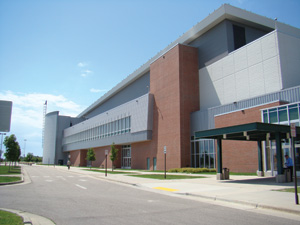


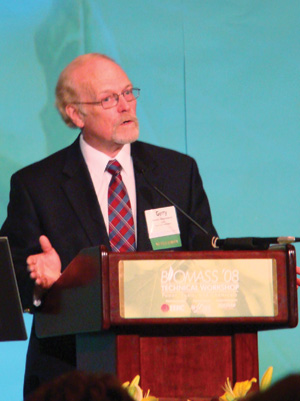
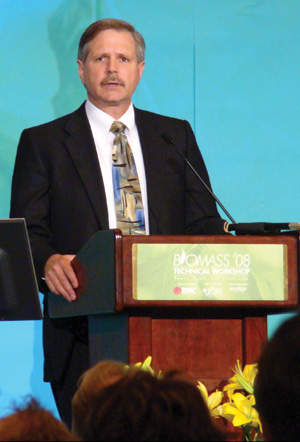
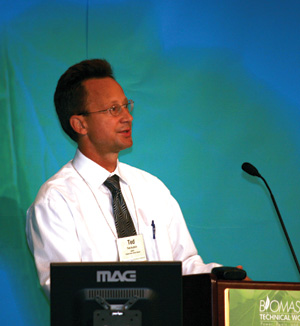
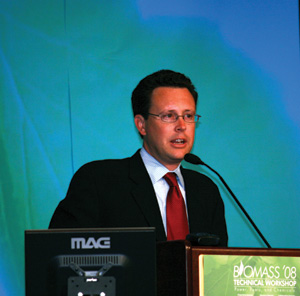
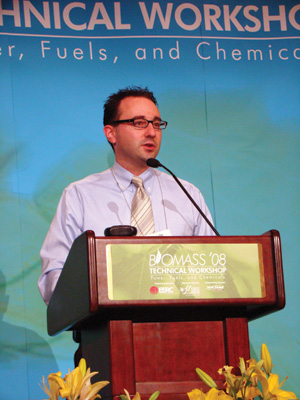
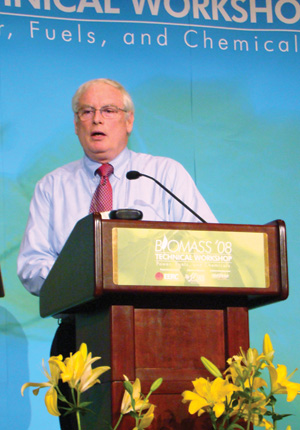
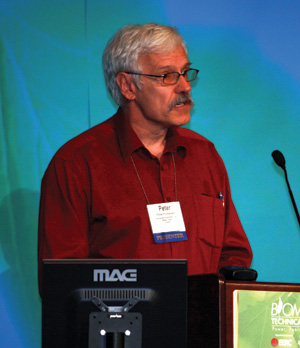















January 1, 1970
BY Ron Kotrba, Jerry W. Kram, Bryan Sims, Anna Austin
The director of the Energy & Environmental Research Center, Gerald Greonewold, is known for his straightforwardness. In mid-July the EERC hosted the Biomass '08 Technical Workshop in Grand Forks, N.D. In his welcoming address to attendees, Groenewold reminded everyone that there are several ways for the United States to achieve energy security. "With respect to biomass, a word of caution," he said. "I think a lot of people think we're just going to move into biomass and a few other things like wind and hydro technology-we support all of that. But anyone who thinks fossil energy is just going to go away is deadly mistaken. Fossil energy is a key part of the research portfolio here at EERC, and it's going to be around for the foreseeable future." That portfolio consists of 433 active contracts worth $224 million with entities from all 50 states and 50 countries.
The country needs energy security but to speak of energy "independence" is an insult to our friends to the north and south where we import oil from, Groenewold said. "I'm not going to say we're going to find energy independence in this country, but I do think we can find energy security by working with partners-strategic partners around the world," said Groenewold, who is an advocate of partnerships as a means to success. "Oil at $140 a barrel certainly provides incentives to look at alternative fuels, but it also gives a lot of incentive to go after hard-to-find oil."
Groenewold took the opportunity to dispel two "urban myths," as he called them. "Urban myth No. 1-the world is running out of petroleum," he said. "This is absolutely a myth. It's silly. As a geologist I can tell you, we're not running out of petroleum." There is, however, a reduction in the rate at which it can be pumped out of the ground.
To emphasize his point about the oil situation, Groenewold referenced the Bakken Formation in western North Dakota and eastern Montana. "The average well there right now costs $6.5 million," he said. "That's a lot of money and you wouldn't do that if oil was only $40 a barrel." The Bakken Formation is "an enormous resource about the size of Saudi Arabia," he told the audience.
Urban myth No. 2 is that there is a global water crisis. "It's worse than that," he said. "There is a global water catastrophe. We are out of water or we've polluted it. A hundred of the largest cities in China are sitting on groundwater that's at least 80 percent unusable. I predict today that the next war in the world will be fought over water-with guns." On top of this, he added we are moving toward a severe drought, so judicious use of water is paramount.
Fossil energy is an important part of the EERC's portfolio, but so is biomass. "As far as new research goes, one of the areas we're very excited about is algae," Groenewold said. "I was fortunate enough to be part of a group of eight people invited in May to be the first delegation to go to Israel representing various enterprises." He said top algae experts say it's not the conversion of algae to biofuels that is difficult. "The real challenge is producing adequate feedstock, so we're working on some very sophisticated programs on algae."
One of the EERC's algae research projects involves finding a replacement for JP-8 military-grade jet fuel. The EERC received one of three awards in the nation from the U.S. Defense Advanced Research Projects Agency to do this research and has completed its first charge to demonstrate ability. "We're now moving toward a second program there," he said. Also, within the next year, North Dakota will become home to a pilot plant using petrochemical technology to make urea fertilizer from biomass.
Following his opening remarks, Groenewold introduced North Dakota Gov. John Hoeven. In 2001, Hoeven spearheaded the development of a comprehensive energy plan to develop all of the state's energy sources such as coal, natural gas, oil, agriculture-based fuels, wind and biomass. "We're now building on that and have put together a commission to [look at] how we can improve," he said. "It's about creating partnerships and synergies for new technologies to produce more energy, and to do it in environmentally friendly ways."
In the last legislative session, lawmakers created a biomass incentive and research fund, and a renewable energy fund. The program includes financial assistance for engineering and design of cellulosic ethanol and related biomass projects. It also provides incentives to the agricultural community to demonstrate the production, harvest, storage and delivery of biomass feedstocks on a commercial scale, and to support biomass projects during the first few critical years.
"We need to empower North Dakota to continue developing partners, and that's where you all come in," Hoeven said. "You have the expertise, you have the experience, and you have the knowledge to develop the technology we need to make it happen."
Gasification Tutorial
The pre-workshop session was devoted to gasification. The tutorial was kicked off with a presentation by Nikhil Patel, an EERC research scientist, who began by lighting a match.
The flame signified combustion and, after he blew it out, Patel pointed to the rising smoke and told the audience he had just made a gasifier. Gasification is substoichiometric combustion of fuel, which means the air accelerates combustion and is restricted to form gas-the same thing that happens when the flame of a match is blown out.
Learning from history, Patel said the first gasifiers in the Bronze and Iron Ages were actually used to make charcoal, which acted as a reducing agent for high-temperature metal-making as far back as 3,000 B.C. With the charcoal as the primary product the gas was mostly vented off. Much later, in 1681, John Clayton ignited the "Spirit of the Coal," or synthesis gas, to produce lamplight. However, the importance of a self-sustained carbonization process using controlled air combustion, or what Patel says was an important first step in developing modern gasification processes, wasn't discovered until later. Throughout the 1800s gas lighting was popular but by 1910, electricity came into a light of its own.
In 1920, Franz Fischer and Hans Tropsch invented a process to catalytically reform synthesis gas into liquid fuels. Twenty-four years later, during the height of World War II, the Germans used the F-T process to produce 124,000 barrels of fuel a day from more than 25 plants in order to sustain adequate fuels production to run its equipment.
The theory of gasification was the topic of a presentation by Paul Pansegrau, an EERC research scientist. Coal varies in quality, and in many ways can approximate biomass. Experience in coal can only lend itself to more effective utilization of biomass. Pansegrau spoke of the four major steps to gasification: drying, devolatilization, carbonization and gasification/combustion. He said biomass volatiles are much higher than coal, but in turn is inherently low in sulfur and nitrogen content. After carbonization, char is produced, there's good char and bad. Good char is porous, has the right mineral content, possesses good reactivity and is high in carbon monoxide and hydrogen. Bad char is nonporous, has bad reactivity and only makes carbon monoxide. There are ways to work around bad char, which are likely more art than science, Pansegrau said. Carbon monoxide and hydrogen are the desired main components of synthesis gas. High-temperature gasification produces more carbon monoxide and hydrogen, and less carbon dioxide. During the audience question and answer period one person asked if a gasifier that can use coal and biomass exists. Pansegrau said it is best to use a gasification system designed for biomass.
There are 142 commercial gasification plants in the world employing more than 420 gasifiers, the thermal generating capacity of which is 56,000 megawatts, said EERC Senior Research Manager Mike Swanson. The feedstock breakdown for these plants is 55 percent coal and 32 percent petroleum residue; the remaining 13 percent is a mix of feedstocks, including a small amount of biomass. Forty-four percent of the end products are chemicals, 30 percent F-T fuel, and 18 percent power. Asia has 32 percent of the world's syngas productive capacity, while Africa and the Middle East make 28 percent, Europe is a close third at 25 percent, and the Americas north, central and south come in last at 15 percent.
Ron Kotrba is a Biomass Magazine senior writer. Reach him at rkotrba@bbiinternational.com or (701) 738-4942. Jerry W. Kram, Bryan Sims, Anna Austin and Ryan C. Christiansen are Biomass Magazine staff writers. Reach them at jkram@bbiinternational.com or (701) 738-4920, rchristiansen@bbiinternational.com or (701) 373-8042, aaustin@bbiinternational.com or (701) 738-4968 and bsims
@bbiinternational.com or (701) 738-4950.
The country needs energy security but to speak of energy "independence" is an insult to our friends to the north and south where we import oil from, Groenewold said. "I'm not going to say we're going to find energy independence in this country, but I do think we can find energy security by working with partners-strategic partners around the world," said Groenewold, who is an advocate of partnerships as a means to success. "Oil at $140 a barrel certainly provides incentives to look at alternative fuels, but it also gives a lot of incentive to go after hard-to-find oil."
Groenewold took the opportunity to dispel two "urban myths," as he called them. "Urban myth No. 1-the world is running out of petroleum," he said. "This is absolutely a myth. It's silly. As a geologist I can tell you, we're not running out of petroleum." There is, however, a reduction in the rate at which it can be pumped out of the ground.
To emphasize his point about the oil situation, Groenewold referenced the Bakken Formation in western North Dakota and eastern Montana. "The average well there right now costs $6.5 million," he said. "That's a lot of money and you wouldn't do that if oil was only $40 a barrel." The Bakken Formation is "an enormous resource about the size of Saudi Arabia," he told the audience.
Urban myth No. 2 is that there is a global water crisis. "It's worse than that," he said. "There is a global water catastrophe. We are out of water or we've polluted it. A hundred of the largest cities in China are sitting on groundwater that's at least 80 percent unusable. I predict today that the next war in the world will be fought over water-with guns." On top of this, he added we are moving toward a severe drought, so judicious use of water is paramount.
Fossil energy is an important part of the EERC's portfolio, but so is biomass. "As far as new research goes, one of the areas we're very excited about is algae," Groenewold said. "I was fortunate enough to be part of a group of eight people invited in May to be the first delegation to go to Israel representing various enterprises." He said top algae experts say it's not the conversion of algae to biofuels that is difficult. "The real challenge is producing adequate feedstock, so we're working on some very sophisticated programs on algae."
One of the EERC's algae research projects involves finding a replacement for JP-8 military-grade jet fuel. The EERC received one of three awards in the nation from the U.S. Defense Advanced Research Projects Agency to do this research and has completed its first charge to demonstrate ability. "We're now moving toward a second program there," he said. Also, within the next year, North Dakota will become home to a pilot plant using petrochemical technology to make urea fertilizer from biomass.
Following his opening remarks, Groenewold introduced North Dakota Gov. John Hoeven. In 2001, Hoeven spearheaded the development of a comprehensive energy plan to develop all of the state's energy sources such as coal, natural gas, oil, agriculture-based fuels, wind and biomass. "We're now building on that and have put together a commission to [look at] how we can improve," he said. "It's about creating partnerships and synergies for new technologies to produce more energy, and to do it in environmentally friendly ways."
In the last legislative session, lawmakers created a biomass incentive and research fund, and a renewable energy fund. The program includes financial assistance for engineering and design of cellulosic ethanol and related biomass projects. It also provides incentives to the agricultural community to demonstrate the production, harvest, storage and delivery of biomass feedstocks on a commercial scale, and to support biomass projects during the first few critical years.
"We need to empower North Dakota to continue developing partners, and that's where you all come in," Hoeven said. "You have the expertise, you have the experience, and you have the knowledge to develop the technology we need to make it happen."
Gasification Tutorial
The pre-workshop session was devoted to gasification. The tutorial was kicked off with a presentation by Nikhil Patel, an EERC research scientist, who began by lighting a match.
The flame signified combustion and, after he blew it out, Patel pointed to the rising smoke and told the audience he had just made a gasifier. Gasification is substoichiometric combustion of fuel, which means the air accelerates combustion and is restricted to form gas-the same thing that happens when the flame of a match is blown out.
Learning from history, Patel said the first gasifiers in the Bronze and Iron Ages were actually used to make charcoal, which acted as a reducing agent for high-temperature metal-making as far back as 3,000 B.C. With the charcoal as the primary product the gas was mostly vented off. Much later, in 1681, John Clayton ignited the "Spirit of the Coal," or synthesis gas, to produce lamplight. However, the importance of a self-sustained carbonization process using controlled air combustion, or what Patel says was an important first step in developing modern gasification processes, wasn't discovered until later. Throughout the 1800s gas lighting was popular but by 1910, electricity came into a light of its own.
In 1920, Franz Fischer and Hans Tropsch invented a process to catalytically reform synthesis gas into liquid fuels. Twenty-four years later, during the height of World War II, the Germans used the F-T process to produce 124,000 barrels of fuel a day from more than 25 plants in order to sustain adequate fuels production to run its equipment.
The theory of gasification was the topic of a presentation by Paul Pansegrau, an EERC research scientist. Coal varies in quality, and in many ways can approximate biomass. Experience in coal can only lend itself to more effective utilization of biomass. Pansegrau spoke of the four major steps to gasification: drying, devolatilization, carbonization and gasification/combustion. He said biomass volatiles are much higher than coal, but in turn is inherently low in sulfur and nitrogen content. After carbonization, char is produced, there's good char and bad. Good char is porous, has the right mineral content, possesses good reactivity and is high in carbon monoxide and hydrogen. Bad char is nonporous, has bad reactivity and only makes carbon monoxide. There are ways to work around bad char, which are likely more art than science, Pansegrau said. Carbon monoxide and hydrogen are the desired main components of synthesis gas. High-temperature gasification produces more carbon monoxide and hydrogen, and less carbon dioxide. During the audience question and answer period one person asked if a gasifier that can use coal and biomass exists. Pansegrau said it is best to use a gasification system designed for biomass.
There are 142 commercial gasification plants in the world employing more than 420 gasifiers, the thermal generating capacity of which is 56,000 megawatts, said EERC Senior Research Manager Mike Swanson. The feedstock breakdown for these plants is 55 percent coal and 32 percent petroleum residue; the remaining 13 percent is a mix of feedstocks, including a small amount of biomass. Forty-four percent of the end products are chemicals, 30 percent F-T fuel, and 18 percent power. Asia has 32 percent of the world's syngas productive capacity, while Africa and the Middle East make 28 percent, Europe is a close third at 25 percent, and the Americas north, central and south come in last at 15 percent.
Ron Kotrba is a Biomass Magazine senior writer. Reach him at rkotrba@bbiinternational.com or (701) 738-4942. Jerry W. Kram, Bryan Sims, Anna Austin and Ryan C. Christiansen are Biomass Magazine staff writers. Reach them at jkram@bbiinternational.com or (701) 738-4920, rchristiansen@bbiinternational.com or (701) 373-8042, aaustin@bbiinternational.com or (701) 738-4968 and bsims
@bbiinternational.com or (701) 738-4950.
Advertisement
Advertisement
Advertisement
Advertisement
Upcoming Events





